6. Vivre Sa Vie
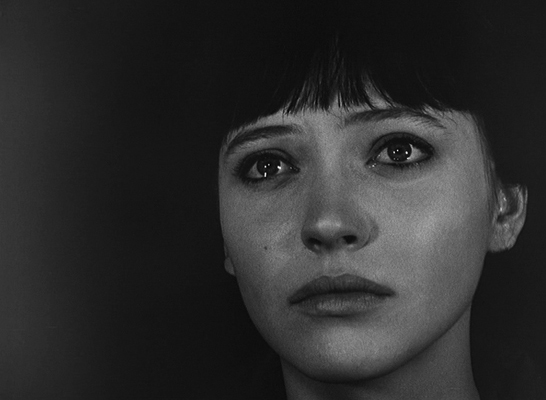
Mentioning Jean Luc-Godard, Anna Karina and music in the same sentence likely brings the ‘Maddison dance’ scene in Bande à part (1964) to mind. The continuous influence of this iconic musical moment is apparent in its role as inspiration for the John Travolta-Uma Thurman dance in Pulp Fiction (1994). But it is a different Godard film we turn to here.
In Vivre Sa Vie (1962) or ‘My Life to Live’- an early Godard film- we follow Nana (Anna Karina) who aspires to be an actress. Financial desperation soon leads her towards prostitution. And so- over the course of twelve episodes we see Nana’s spiralling descent. It is in the ninth episode that we experience what is perhaps the saddest “happy” dance scene in cinema.
It is the subtext of this dance scene that gives it such power. Nana’s pimp has dragged her to a meeting. She had been promised a movie and instead has to wait around for these men to finish the meeting. It reinforces to Nana that she has lost her agency. And so, in an effort of reclaiming that agency – she plays a song on the jukebox and begins to dance.
The song- ‘Swing Swing Swing’ by Michel Legrand, famed for his score for The Umbrellas of Cherbourg (1964) and subsequent Hollywood career- begins to play. The song is an upbeat jazzy piece. Nana, with her joyful-seductive demeanour waltzes around the room.
The three men offer her the occasional glance: the pimp and his business partner- more so in annoyance. The man playing pool- in his best Buster Keaton-Stone Face impression- gives nothing away and continues his game. Aside from Nana, it is the room’s lack of life that really accentuates the subtext. As the song ends she hugs a pillar- exhausted, a half-smile on her face- but her isolation is there for all to see.
Should you watch this scene out of context it would likely instil excitement and joy in you. But it is this very fact- when understanding the subtext- that makes it such a powerful scene. The music and Nana’s dance excites – more so than any part of the film- yet you understand that this is but a façade. This juxtaposition makes the scene intensely powerful. We experience great sympathy for Nana but we know that no one will help her.
7. Before Sunrise
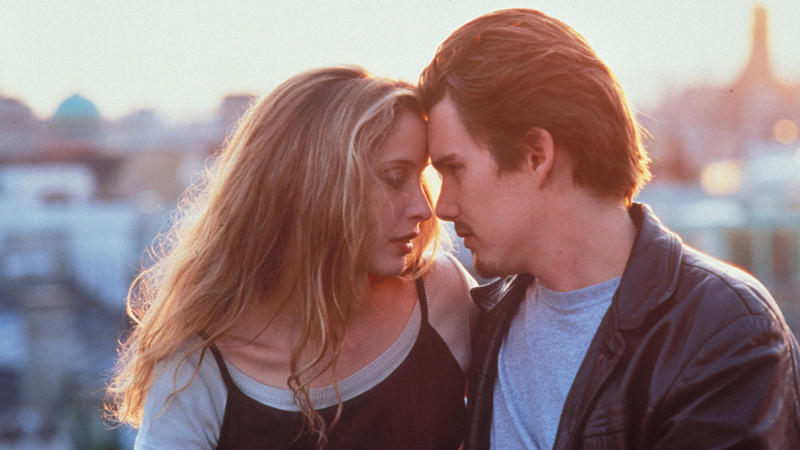
Richard Linklater’s ‘Before’ trilogy has a number of iconic and powerful musical scenes. In Before Sunset (2004) one instantly thinks of Celine’s (Julie Delpy) performance of ‘A Waltz for a Night’ and in Before Sunrise (1995) we think of the young love symbolised in Kath Bloom’s ‘Come Here’ playing whilst Jesse (Ethan Hawke) and Celine repeatedly catch one another’s eyes but neither holding that look. But for this list, we turn to Before Sunrise’s final images.
The film follows Jesse and Celine- two strangers who meet on a train bound for Paris. Jesse- who has twenty-four hours to spare in Vienna before his flight- acknowledges that a spark exists between them and asks Celine to accompany him around Vienna for the next twenty-four hours. She impulsively agrees. And so- we get to know these characters as they simply walk around Vienna having conversations- going to bars, a graveyard, a park and a fairground.
By the end of the film we have grown attached to these characters and the unique experience they have shared. Despite the fact that we are swept up in their romance, we also appreciate their flaws. This is a testament to the strong writing of Linklater, Delpy and Hawke. This attachment to the characters allows for the music in the final scene to then attain its truly visceral power.
As Celine and Jesse say their goodbyes a harpsichord begins to play. It is reminiscent of an earlier scene in which Jesse and Celine listen to a man playing the instrument. Doing so- they stop and look at each other, “taking a picture” of one another- so as to never forget the moment. This in itself reflects the power of the final scene.
As the harpsichord plays and Jesse and Celine go their separate ways- we are presented with images of all the significant places they had been to during their short time together- a café- with two now empty seats, an old-town alley and the park in which they made love. We yearn for these moments to last forever but all that remains are echoes.
This finale is true to Linklater’s thematic preoccupations- the passing of time. The harpsichord encapsulates this. It reminds us that there are wonderful moments in life, but like all moments they pass. The harpsichord concludes with a trill before ending in perfect cadence. This experience is now but a memory. But in the context of the subsequent films- where we find that life is not all romance- this sense of nostalgia emanating from the harpsichord is even stronger. We must treasure moments such as these.
8. The Wicker Man
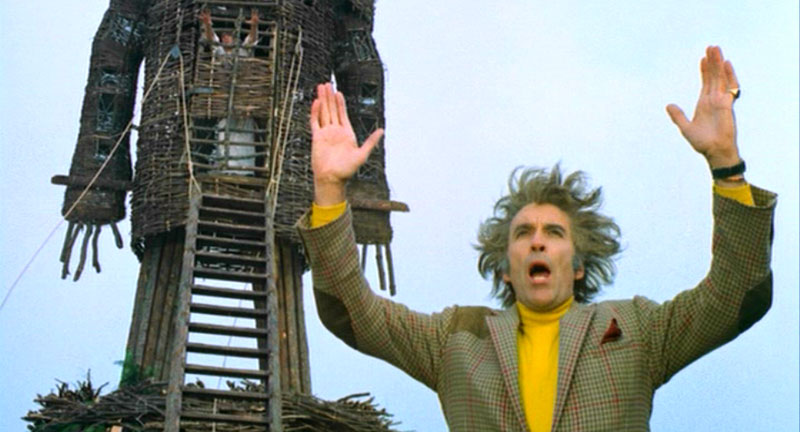
The shocking and scintillating twist ending of The Wicker Man (1973) continues to hold its own in the horror pantheon. The film’s cult status and influence persists, to the point that it is sometimes referred to as the “Citizen Kane of horror movies”
The film follows Sergeant Neil Howie (Edward Woodward), a policeman from mainland Scotland, who comes to the isolated island of Summerisle in order to investigate a missing girl. Music is integral to the unique and eerie atmosphere of The Wicker Man. In this “almost, but not quite” musical- Paul Giovanni’s folk driven soundtrack constantly toys with our psyche.
In songs like ‘The Landlord’s Daughter’ and ‘Gently Johnny’, Giovanni awakens our hedonistic side. We almost want to join in the party. But yet- we know something is amiss with the island’s strange populace. This internal battle does much for the film’s atmosphere.
As Howie is finally caught in Lord Summerisle’s (Christopher Lee) sacrificial web, the citizens of Summer Isle begin their rendition of ‘Summer is A-comen In’ and Howie is proceeded to be burned alive inside a giant wicker man.
The song now reveals exactly what was amiss and why we reacted with such distrust to this joyous sex-folk driven society. As Howie defiantly preaches of God, the island’s inhabitants all gather round the burning wicker man in sheer delight. They do not see a shocking murder but a salvation. By luring the virgin Howie here- they believe their crops to be saved.
What truly allows the juxtaposition of joy and horror to be so effective is what it tells us about ourselves. In essence, humans- without being innately evil- can do evil acts in the service of an ideology. This is reinforced by the image of pub landlords, shopkeepers, teenagers and children, dancing and singing to the burning of an innocent man. This musical number leaves us with perhaps the greatest ending in horror movie history.
9. Amadeus
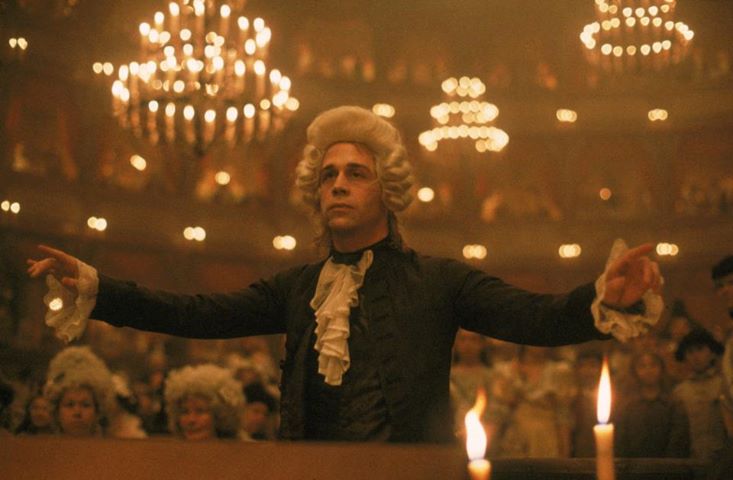
In 1985, Milos Forman’s Amadeus (1984) deservingly swept the Oscars, winning eight awards in the process. Based on the stage-play, it depicted the fictional relationship of Antonio Salieri (F. Murray Abraham) and Wolfgang Amadeus Mozart (Tom Hulce)- the former’s admiration and jealousy for the latter being the film’s focal point.
Early in the film, Salieri- now in his old age- describes the first time he heard Mozart’s music. That piece of music is the mesmerising ‘Serenade for Winds, No. 10 in B Flat Major’. While the composition is a powerful masterpiece in its own right- it is the description of this perfection- a credit to both the writing of Peter Shaffer and performance of Abraham- that adds an even greater quality to the scene.
Salieri’s description of “the voice of God” is an instrument in its own right. The dialogue offers an added poetic melody- interweaving various artistic forms into one whole composition. The contrapuntal texture of music and poetry offers an added dimension of meaning and beauty to Mozart’s Serenade. It transforms it into something else- something uniquely cinematic.
It is rare to find dialogue and music that interacts like this in cinema. Often the latter is there to serve the former. Here it is the opposite. We immerse ourselves, captivated by every harmonious nuance- the slightest semi-quaver. We are made to listen. Truly listen.
As a result, we not only appreciate the beauty of Mozart’s composition but are able truly understand Salieri’s seething jealousy that someone as unceremonious as Amadeus’ Mozart was able to compose such a masterpiece. The power of this scene emerges in that we are not told that Serenade is a masterpiece (even though we are…) but that we are invited to find this out for ourselves.
10. Whiplash
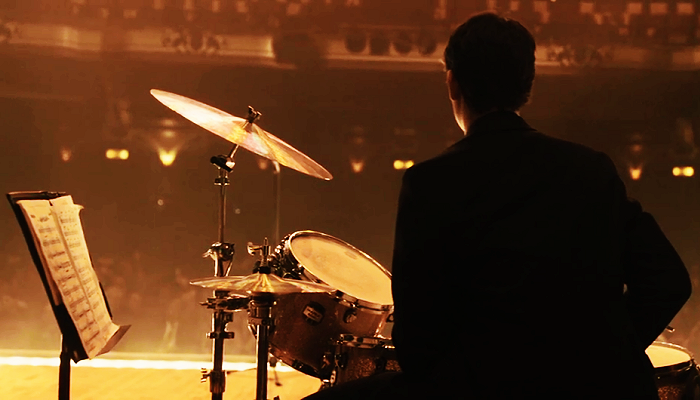
Music- and specifically jazz music- is integral to the work of Damien Chazelle. In Whiplash (2014)- Chazelle’s scintillating first feature film- we follow the teacher-student relationship of drummer, Andrew Neiman (Miles Teller) and instructor, Terrence Fletcher (J.K. Simmons). Neiman- a first year jazz student at a prestigious New York music conservatory- comes under the tutelage of the feared but also revered tutor. Both in their own ways aspire to greatness. The film deals with the resulting dedication, obsession and brutality that such a pursuit entails.
Having given his all- even attempting to perform straight after a car-crash only to be told by the brutal Fletcher that he was done- Neiman attacks Fletcher resulting in his expulsion. Prompted by his father, Neiman meets a lawyer representing the parent’s of a former student of Fletcher’s. The student they claim became depressed following bullying tactics by Fletcher and killed himself.
After Neiman agrees to anonymously testify about Fletcher’s methods in an ethics complaint against the conservatory, Fletcher is fired. Much later, Neiman and Fletcher cross paths. They have a drink and meet as equals.
Fletcher explains how his extreme methods were but an effort to take exceptional musicians to the next level- to find the next Charlie Parker. Fletcher invites Neiman to play drums for his professional band at the JVC Jazz Festival where everyone who is anyone will be.
And so- unsurprisingly for those who have seen the film- it is the powerful finale that makes this list. On stage and ready to perform the titular song ‘Whiplash’ it suddenly becomes apparent that Neiman has been given different sheet music. Fletcher menacingly approaches Neiman and tells him he knows that it was he who got him fired. The band begins to play and Neiman desperately seeks to improvise his way out of Fletcher’s trap.
The song ends to uncomfortable silence and Neiman storms off stage distraught. Unexpectedly for Fletcher however he turns back and returns- interrupting Fletcher- he begins to play ‘Caravan’. He queues the band in and looks to prove his greatness.
The ‘Caravan’ finale plays out like an action film. Camera shots and movement, editing and sound all interact with the music to create what is essentially a war-zone. Such technique perfectly encapsulates the thematic drive of the film- the lengths one must go to achieve greatness. The scene uses cinematic technique to provide one of the greatest visual representations of music ever filmed.
As the drums dominate the shots are edited with a staccato rhythm. It moves at a pace reminiscent of a fight scene- we see everything from the sheet music, symbols being hit, to reaction shots- all within a single second. As the brass takes over we see tracking shots of them swiftly move to the right and then jarringly move in analogous motion to the left as another section takes over.
The frantic nature of the music and its visualisation not only captures the character of the song, it encapsulates the destructive nature of both Neiman and Fletcher’s obsessions. Throughout – as the frenetic nature of the scene grows- so grows Fletcher’s respect for Neiman.
As Neiman begins his solo- the rapid editing continues. We see blood dripping from his fingers and sweat falls from his ear as the music becomes muffled. The murmuring sound is reminiscent of that used to depict shell shock in films such as Saving Private Ryan. We feel the stress and adrenaline.
As the solo reaches its crescendo- we see Fletcher put aside his animosity as he senses greatness for both himself and Neiman. Where their craving for success pitted them in opposition- it has now become one shared endeavour.
Like the climax of a war-film we feel the anxiety of the final battle- everything is on the line. We listen to every beat- hoping that it’s in perfect time. As this cacophony of sheer musical ecstasy ends- both men have found greatness regardless of the moral and social fallout such a quest for excellence has and will create.